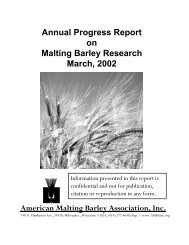Annual Progress Report on Malting Barley Research March, 2007
Annual Progress Report on Malting Barley Research March, 2007
Annual Progress Report on Malting Barley Research March, 2007
Create successful ePaper yourself
Turn your PDF publications into a flip-book with our unique Google optimized e-Paper software.
Minnesota barley disease survey and collecti<strong>on</strong> of pathogen isolates.<br />
Disease surveys are useful for identifying ec<strong>on</strong>omically important pathogens of barley<br />
and determining their impact <strong>on</strong> yield and quality. A survey was made in the<br />
northwestern part of Minnesota (the primary barley producti<strong>on</strong> area in the state) to<br />
ascertain the prevalence and importance of barley diseases in 2006. Nine fields were<br />
visited during the survey c<strong>on</strong>ducted <strong>on</strong> July 12-14. FHB was the most comm<strong>on</strong> disease<br />
and detected in 67% of surveyed fields, with observed severities ranging from 0% to<br />
0.2% (Table 1). Net blotch was the next most comm<strong>on</strong> disease and was observed in<br />
56% of fields. Net blotch severity ranged from trace to 30%. Other diseases identified<br />
in the survey included bacterial blight, SSLB and crown rust. FHB c<strong>on</strong>tinues to be a<br />
major disease problem <strong>on</strong> six-rowed barley in the regi<strong>on</strong> as it has for the past 14 years.<br />
However, the severity of FHB was am<strong>on</strong>g the lowest observed for this survey in many<br />
years. This was likely due to the very dry weather in northwestern Minnesota. Net<br />
blotch has and c<strong>on</strong>tinues to be a comm<strong>on</strong> disease in barley. In 2005, bacterial blight<br />
was widespread in Minnesota. In 2006, this disease was found again in a number of<br />
fields. Crown rust can be a comm<strong>on</strong> disease in Upper Midwest barley fields—its<br />
severity in any <strong>on</strong>e year can vary dramatically.<br />
Determine the virulence phenotype of pathogen isolates and maintain a<br />
pathogen isolate collecti<strong>on</strong>. Pathogen isolates are an essential resource for<br />
resistance breeding efforts and the identificati<strong>on</strong> of novel sources of disease resistance.<br />
We have over 1000 isolates of various barley pathogens stored at the University of<br />
Minnesota. Over the past year, we tested the viability of all isolates and are in the<br />
process of compiling a database (place of collecti<strong>on</strong>, cultivar of origin, virulence pattern,<br />
etc.) <strong>on</strong> them. We collected more pathogen isolates from the 2006 barley disease<br />
survey. These isolates will be purified and stored for future virulence evaluati<strong>on</strong>s. We<br />
c<strong>on</strong>duct the leaf rust virulence surveys for the United States. In 2006, seven isolates of<br />
P. hordei (leaf rust) were received from around the country. Our lab c<strong>on</strong>tinues to serve<br />
the barley community by testing germplasm for resistance to various diseases and<br />
supplying cooperators with pathogen cultures and germplasm for their studies. As<br />
coordinator for disease and pest resistance genes for the Internati<strong>on</strong>al <strong>Barley</strong> Genetics<br />
Committee, I also supply informati<strong>on</strong> to cooperators <strong>on</strong> the genetics and mapping of<br />
resistance genes.<br />
Other barley research projects funded from other sources. We c<strong>on</strong>duct a<br />
number of other barley research projects in additi<strong>on</strong> to those funded by AMBA. These<br />
are listed below.<br />
Other <strong>Barley</strong> <strong>Research</strong> Projects<br />
Sub-cellular localizati<strong>on</strong> and functi<strong>on</strong>s of the barley stem rust resistance<br />
receptor-like serine/thre<strong>on</strong>ine-specific protein kinase Rpg1. The Rpg1 gene<br />
c<strong>on</strong>fers resistance to many pathotypes of the stem rust fungus Puccinia graminis f. sp.<br />
tritici and has protected barley from serious disease losses for over 60 years. Rpg1<br />
encodes a c<strong>on</strong>stitutively expressed protein with two tandem kinase domains.<br />
35
















